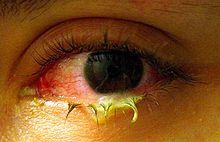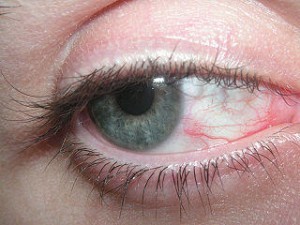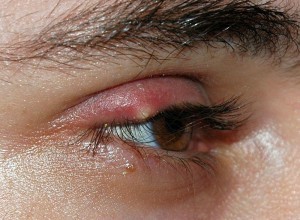Eye Mucus (Excessive & Crusty) – Causes and Symptoms
The discharge of eye mucus is a normal physiological process. The mucuous membranes of the conjunctiva secretes this mucus in small quantities. It mixes with tears an oily substance (meibum) and dead skin cells to become thick and watery. However, when exposed to air for long periods it may harden and form a crust. This is more prominent when awaking after sleep. For this reasons, it is often referred to as sleep dust. Hardened eye mucus is also known as eye gunk or eye boogers but the more correct medical term is rheum.
Small amounts of eye mucus is not usually a problem. Eye mucus is very similar to nasal mucus. The nasal cavity is also lined by mucous membranes and when this mucus is hardens, it forms crusts that we commonly refer to as boogers. However, crusted eye mucus like nasal mucus poses no significant problem to the eye. When the mucus is excessive and the crusting forms large masses then it may be a sign of certain diseases. It can make opening and closing of the eyelid a little difficult and sometimes painful. And larger crusts can scratch the conjunctiva if it is not appropriately removed.
Why does eye mucus form?
Mucus is constantly produced by the outer lining of the eyes like the conjunctiva. It helps to keep these outer eye linings moist as the exposure to the air may dry it out. There is also another oily substance secreted by the meibomian glands which is known as meibum. It is similar to skin oils. Tears are also constantly released from the lacrimal glands. These tears, along with the movement of the blinking eyelids, washes away the mucus. Most of us never eye realize that this process occurs. Contact lens wearers may sometimes find streaks of the mucus on their contact lenses. Otherwise it is not usually seen during waking hours.
During sleep, tear production reduces and blinking does not occur as the eyelids are closed. As a result the mucus may accumulate and form hard crusts usually at the corners of the eye (canthi). Nasal mucus may sometimes become mixed with the eye mucus. This entire process is normal. Sometimes the eye mucus changes. Pus may also be discharged and mix with the mucus. This discharge is known as a mucopurulent discharge. It is not normal. Neither is mucus that is excessive, clouding the vision, crusting to almost seal the eyelids shut or large crusts that causes discomfort or even pain.
Precautions
Most of us simply clean the crusted mucus with our fingers, a cloth or with soap and water. However, very hard crust and large masses may not be as easy to clean. Peeling or scratching it out forcefully can injure the eyelid, skin around the eyes and even the eyeball itself. The underlying condition that causes excessive mucus and hard crusts should be treated. Always speak to a doctor about how the crust should be removed. Do not use extreme force.
Causes of Excessive Eye Mucus
There are several reasons why the eye mucus may become excessive, or accumulate and harden. Here are some of the causative conditions.
Dry Eyes
A lack of sufficient tears means that the eye mucus is not frequently washed away. Dryness can increase the risk of injury and infections of the eye, which in turn can worsen the excessive mucus discharge. Sometimes dry eyes occurs momentarily due to transient environmental and lifestyle factors. However, persistent dry eyes may occur for a number of reasons, including:
- Environmental conditions like wind and dry air.
- Age – tear production decreases with age, especially after 50 years.
- Certain medication including anti-hypertensive drugs, antihistamines and some antidepressants.
- Hormone changes associated with menopause.
- LASIK and other refractive eye surgeries.
- Vitamin A deficiency.
- Autoimmune diseases like systemic lupus erythematosus (SLE), Sjogren’s syndrome and rheumatoid arthritis.
- Diabetes mellitus.
- Thyroid problems.
- Eye strain
- Prolonged contact lens wearing
- Blocked tear ducts
Symptoms
Dry eyes are a symptom. Other symptoms include:
- Watery or stringy mucus.
- Eye discomfort or pain.
- Gritty feeling in the eyes.
- Redness.
Infectious Conjunctivitis
Inflammation of the conjunctiva is known as conjunctivitis or is referred to commonly as “pink eye”. It is usually an acute condition that is due to infections. Viral conjunctivitis is by the most common. Other microbes that may cause conjunctivitis includes bacteria and fungi. The infection can also extend to the cornea, a condition known as infectious keratitis.
Symptoms
- Mucus varies from watery to sticky and gooey due to the presence of pus (mucopurulent eye discharge).
- Extensive redness and swelling of the eye.
- Burning sensation of the eye and pain.
- Itchiness and grittiness of the eyes.
Allergic Conjunctivitis
Allergic conjunctivitis is the inflammation of the conjunctiva due to an immediate-mediated hypersenstivity reaction. This simply means that the immune system overreacts to otherwise harmless substances and results in inflammation. People with repeated episodes of allergic conjunctivitis often have other similar allergic conditions like allergic rhinitis (hay fever).
Symptoms
- Watery to stringy eye mucus.
- Severe itching of the eyes.
- Gritty feeling in the eyes (similar to sand in the eyes).
- Redness, swelling and heat.
- Other allergic symptoms usually of the nose (sneezing, nasal congestion and runny nose)
Blepharitis
Inflammation of the eyelid(s) is known as blepharitis. It contains meibomian glands and conjunctiva which may also be affected. Furthermore the inflammation may affect normal movement and closing of the eyelid. Sometimes a problem with the eye extend to the eyelid(s). For these reasons, excessive mucus discharge may occur with crusting.
Symptoms
- Sore and swollen eyelids.
- Itchy eyes and eyelids with a gritty feeling.
- Excessive tearing and eye mucus
- Sticky mucus and eye crusts.
- Redness of the eyes.
- Light sensitivity.
Stye
A stye (hordeolum) is a painful bump that forms of the edge of the eyelid. The lump is often filled with pus. Styes arise with a bacterial infection and can be associated with poor hygiene. It may also occur with eyelid conditions like blepharitis. Most styes resolve on its own within a few days and treatment is not required. However, sometimes styes can persist and lead to complications.
Symptoms
- Red lump (similar to a boil or pimple)
- Pain and swelling of the eyelid
- Excessive tearing with eye redness
- Sticky mucus with crusting over eyelids



